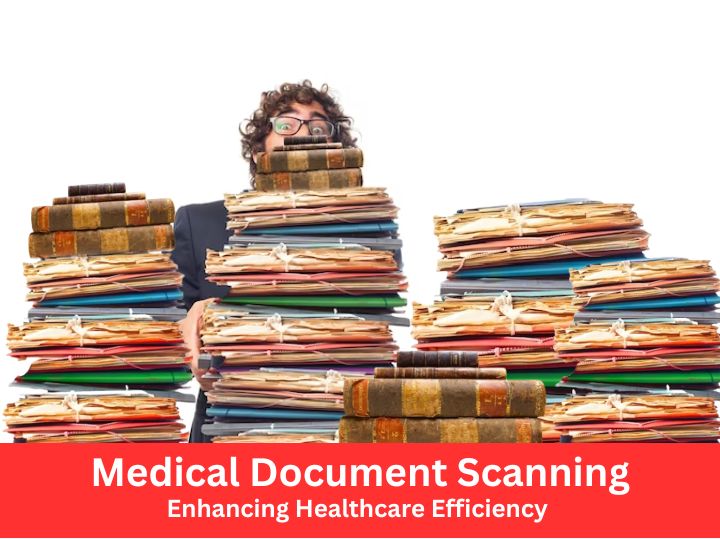Embracing Innovation in Healthcare
In the rapidly evolving world of healthcare, embracing innovative technologies is paramount. Medical document scanning, record digitization, and OCR (Optical Character Recognition) technology have emerged as key players in revolutionizing how medical information is managed, stored, and accessed. In this article, we’ll explore the various facets of these technologies and how they are contributing to a more efficient, secure, and patient-centric healthcare ecosystem.
Medical Document Scanning: Improving Accessibility and Efficiency
Medical document scanning involves converting physical medical records, documents, and images into digital formats. This transition from traditional paper-based records to electronic documents offers numerous advantages. Firstly, it significantly improves accessibility. Medical professionals can easily retrieve patient information, test results, and treatment histories with just a few clicks. This accessibility translates to quicker decision-making, enhanced patient care, and reduced administrative burdens.
Additionally, digitized records can be securely shared between healthcare providers, leading to seamless collaboration and holistic patient treatment plans. This is especially crucial in situations where a patient’s care involves multiple specialists or facilities.
Medical Record Scanning: Preserving History, Embracing Efficiency
Medical record scanning extends beyond just digitizing current patient documents. It also involves converting historical medical records into electronic formats. This preservation of medical history is invaluable for comprehensive patient care. It ensures that past diagnoses, treatments, and medical trends are readily accessible, aiding physicians in making informed decisions.
Furthermore, the digitization of historical medical records contributes to a decluttered and organized healthcare environment. Physical storage spaces can be repurposed, reducing overhead costs and contributing to a greener approach by minimizing paper usage.
Document Digitization: A Step Towards Sustainability
Document digitization encompasses a wide range of healthcare-related materials beyond medical records, such as invoices, insurance forms, and administrative documents. By digitizing these documents, healthcare facilities can streamline administrative tasks, reduce the risk of errors, and enhance overall efficiency.
HIPAA Compliance: Ensuring Patient Data Security
When dealing with medical information, security and privacy are paramount. The Health Insurance Portability and Accountability Act (HIPAA) sets rigorous standards for protecting patient data. As healthcare providers adopt digital solutions, it’s crucial to ensure that all processes, from scanning to storage, adhere to HIPAA regulations.
Maintaining HIPAA compliance involves employing robust encryption methods, implementing access controls, and regularly auditing the security measures in place. By adhering to these guidelines, healthcare organizations can harness the benefits of digitization while safeguarding sensitive patient information.
OCR Technology: Transforming Images into Actionable Data
Optical Character Recognition (OCR) technology is at the heart of medical document scanning. This technology converts scanned images, including handwritten notes and printed documents, into searchable and editable text. The implications are profound. Physicians can now extract specific data from medical records, such as medications, dosages, and test results, and integrate this information into electronic health records with ease.
The use of OCR technology extends beyond text recognition. It also enables the extraction of structured data, such as dates, numbers, and codes, allowing for more accurate data analysis and reporting.
Enhancing Visual Diagnostics
In the field of medical imaging, capturing images in digital format has revolutionized diagnostics and treatment planning. Medical images can be stored electronically, enabling easy retrieval and comparison. Moreover, digital images can be enhanced and manipulated for clearer visualization, aiding physicians in making precise diagnoses.
Additionally, digital image archives facilitate telemedicine and second opinions. Physicians can securely share images with colleagues for collaborative assessments, regardless of geographic location.
Conclusion: Navigating the Digital Frontier of Healthcare
As healthcare continues its journey into the digital age, medical document scanning, record digitization, and OCR technology stand as pivotal innovations. These advancements are not only streamlining administrative processes but also enhancing patient care, collaboration, and data analysis. Healthcare organizations are paving the way for a more efficient, secure, and patient-centric future. Search for a document scanning company, like ARC Document Solutions, that embraces technologies while adhering to HIPAA compliance.
FAQs
Q: How does medical document scanning benefit patient care?
A: Medical document scanning enhances patient care by providing quick access to vital information, facilitating collaboration among healthcare providers, and enabling informed decision-making.
Q: What is the role of OCR technology in medical records?
A: OCR technology converts scanned medical records into searchable and editable text, allowing for efficient data extraction and integration into electronic health records.
Q: Can digitized medical records be securely shared among healthcare providers?
A: Yes, digitized records can be securely shared, promoting seamless collaboration and comprehensive patient treatment plans.
Q: How does document digitization contribute to sustainability?
A: Document digitization reduces paper usage, streamlines administrative tasks, and repurposes physical storage spaces, contributing to a more sustainable healthcare environment.
Q: What measures should healthcare organizations take to ensure HIPAA compliance?
A: Healthcare organizations should employ robust encryption, implement access controls, and conduct regular security audits to ensure HIPAA compliance when adopting digital solutions.
Q: How does OCR technology impact data analysis in healthcare?
A: OCR technology allows for the extraction of structured data from medical records, enabling more accurate data analysis and reporting for healthcare insights.
